Factorial Practice Problems - Quiz
Choose your answer and write the correct one down. Then click HERE for the answers to this quiz.
NOTE: The transcript from the video is listed below the quiz for your reference.
1. I decided to make a list of my top five movies of all time. If I've got it narrowed down to 20 movies, how many different lists could I make?
- 1460540
- 224060
- 6840
- 116280
- 1860480
While the definition of factorial isn't complicated, it's easy to make them trickier by throwing a lot of them together and adding in some fractions. Test your skills here with some algebraic examples that make you use factorials without many numbers.
Factorial Review
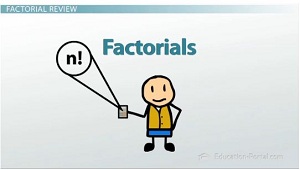 |
For example, in the introductory factorial lesson, we decided that the number of ways eight swimmers could finish an Olympic race was 8! (eight factorial). There were eight people that could finish first, which means there are seven people that could finish second, six could be third, five could be fourth, and on and on and on. And 8 * 7 * 6 * 5 * 4 * 3 * 2 * 1 told us that there were 40,320 different ways those eight people could finish. But if, instead, we were only interested in how many ways the gold, silver, and bronze (first, second, and third) could be handed out, that would imply that we didn't care about who finished fourth or lower. If we don't care about fourth or lower, and cross all those numbers off of the factorial, all we're left with is 8 * 7 * 6, which is 336.
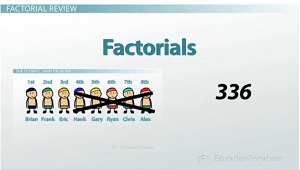 |
So, then the question becomes: could we express 8 * 7 * 6 with factorials? I mean, it's similar, right? We're still multiplying a list of consecutive numbers; it's just that we have a different stopping point. We're not going to continue multiplying until we get to one - we're going to stop somewhere along the way. It turns out that the answer to the question 'how can I write out 8 * 7 * 6 with factorials?' is going to lie in fractions.
8 * 7 * 6 is actually the same as 8! / 5!. Why? Well, maybe if we write it out it will be a little more clear. 8! in the numerator (8 * 7 * 6 * 5 * 4 * 3* 2 *1), 5! in the denominator (5 * 4 * 3 * 2 * 1), and then because I just have multiplication in the numerator and division in the denominator ( a 5 on top divided by 5), it cancels out. A 4 on top, a 4 on bottom cancels out, 3 and 3, 2 and 2, 1 and 1 all cancel out and the only numbers we're left with were the 8, the 7, and the 6 in the numerator. 8 * 7 * 6 = 336. This means that division of factorials just gives us shortened chains of multiplication.
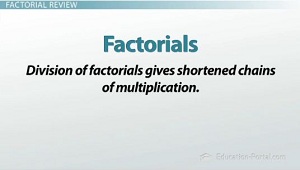 |
Factorial Examples
Let's quickly try a few examples of this. How would we express 22 * 21 * 20 *19 * 18 * 17 * 16 * 15? Well, I want to stop at 15, which means I need to cancel out the 14 and lower. Therefore we just put 22! on the top of the fraction, and 14! on the bottom. It's also good to be able to go the other way. What would 99! / 94! equal? Well, the 94! on the bottom means that the 94 and all the numbers below it would go away (canceled out), so the only ones I'm left with 99 * 98 * 97 * 96 * 95.
As a quick note, while division of factorials has this neat little trick, there is no such trick with multiplication. It is easy to want to turn 5! * 3! into 15!, but that is not true. Maybe writing it all out will show you why this isn't true.
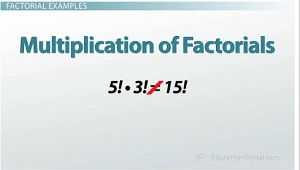 |
5! * 3! = 5 * 4 * 3 * 2 * 1 * 3 * 2 * 1, so that's quite a few numbers. But, 15! is 15 * 14 * 13 * 12 * 11 * 10 * 9 * 8 * 7 * 6 * 5 * 4 *3 * 2 * 1, which is definitely more numbers - a way bigger number - than what we were left with before.
These two facts combined, allow us to do example problems like 7! / (5! *3!). We can first use the 5! in the denominator with the 7! in the numerator to say that 5 and all the numbers below it cancel with 5 and all the numbers below it cancel on the top. So, the 5! in the denominator goes away and I only have 7 * 6 in the numerator. The 3! is still there hanging out. 3! is 3 * 2 * 1 and that's 6. Now that I have a 6 on the top and a 6 on the bottom, I can cancel them out and it equals 7.
Factorial Fractions & Algebraic Expressions
Now, you're ready for the final level of factorial problems - combining factorial fractions with algebraic expressions. Simplify (n + 2)! / n!
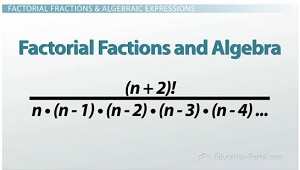 |
These types of problems can be intimidating because the lack of numbers makes it seem entirely different, but that's not the case. We can still use the exact same division of factorial skills we just learned to simplify this factorial expression out. We want to think, how much will cancel out and what will be left over? Well the n! in the denominator can be rewritten as n * (n - 1) * (n - 2) * (n - 3) *… forever or as long as we need to go until we get to 1. While the (n + 2)! on the top is (n + 2) * (n + 1) * n * (n - 1) * (n - 2) and again, on and on as long as it would actually go. Now, we simply have to cancel anything out that's in the numerator and the denominator. There are two ns, there are two (n - 1)s, there are two (n - 2)s, and the rest of these chains in multiplication would be exactly the same, so everything would cancel out. The only two things we would be left with are the two things in the numerator: (n + 2) and (n + 1).
Lesson Summary
We can shorten factorials by dividing by the factorial of all the numbers that we want to cancel out. And, if you are multiplying two factorials together, you cannot multiply the numbers before doing the factorials.